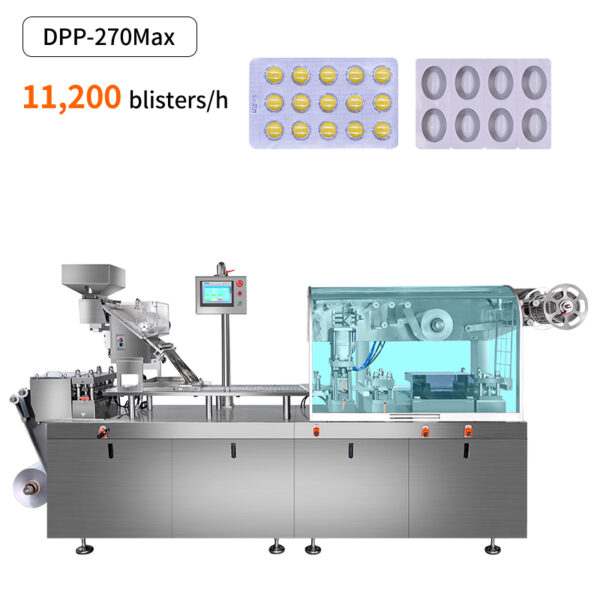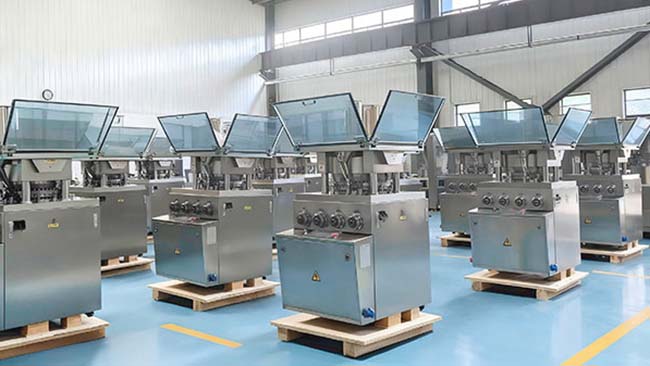Embalagem blister Como um método comum de embalagem farmacêutica na indústria farmacêutica, desde o seu início tem sido a escolha preferida para embalagens de comprimidos de produção em massa na indústria de embalagens farmacêuticas devido à sua ampla gama de aplicabilidade, segurança e reconhecimento de marca. A embalagem blister foi originalmente projetada para embalar comprimidos e cápsulas, substituindo as linhas de embalagem de garrafas de vidro e plástico de alto custo por máquinas de embalagem blister. A embalagem blister provou ser adequada para o transporte e armazenamento de produtos farmacêuticos devido à sua boa vedação ao ar e boa proteção. Na era atual, em que as empresas farmacêuticas estão exigindo cada vez mais embalagens para seus medicamentos, a embalagem blister ainda é o método de embalagem preferido na indústria farmacêutica.

Os fabricantes de produtos farmacêuticos frequentemente optam por comprar a máquina de embalagem blister ideal com base no volume de produção, nas características do produto e na quantidade de embalagens. Existem três tipos comuns de máquinas de embalagem blister no mercado atualmente: rolo, placa e rolo de placa. A máquina de embalagem blister do tipo placa e rolo é a mais comum. Vários tipos de máquinas de embalagem blister têm suas vantagens e desvantagens. Descreveremos suas características em detalhes para ajudá-lo a escolher a máquina mais adequada para seus produtos.
Tipos e características de máquinas de embalagem blister comuns
Máquina de embalagem blister rotativa
A máquina de embalagem blister rotativa opera com base no princípio da termoformagem a vácuo. Possui embalagem contínua, o que permite alta eficiência de produção. É adequada para produção em larga escala devido à sua capacidade de lidar com um volume de produção relativamente alto em um curto espaço de tempo. No entanto, apresenta limitações na formação de blisters profundos. A estrutura e o modo de operação da máquina podem não ser capazes de atingir um formato de blister profundo satisfatório, o que pode ser uma desvantagem para alguns requisitos específicos de embalagem de comprimidos sólidos.
Máquina de embalagem blister de placas
Em uma máquina de embalagem blister de placas, durante o processo de selagem a quente, os moldes superior e inferior fazem contato plano. Este tipo de máquina é mais adequado para a produção de pequenos e médios lotes de produtos farmacêuticos. Apresenta vantagens na embalagem de itens com formatos especiais. Por exemplo, para alguns comprimidos sólidos de formato irregular, a máquina de embalagem blister de placas pode se adaptar melhor ao formato e garantir um acondicionamento preciso. Além disso, possui uma taxa de estiramento da bolha relativamente grande, o que permite maior flexibilidade no design da embalagem e pode acomodar melhor diferentes tamanhos e formatos de comprimidos.

Máquina de embalagem blister de placa rotativa
O máquina de embalagem blister de placa rotativa Combina as vantagens dos tipos rotativo e de placas. Adota um molde de formação de placas planas, que proporciona melhor controlabilidade e precisão no processo de conformação, especialmente para produtos que exigem um formato de blister mais preciso. Ao mesmo tempo, utiliza um método de selagem contínua rotativa, herdando as características de alta eficiência do tipo rotativo. Isso o torna uma opção mais versátil, capaz de atender a uma gama mais ampla de necessidades de produção e requisitos de embalagem para comprimidos sólidos em empresas farmacêuticas.

Seleção de materiais para embalagens blister
Os materiais de embalagem blister para medicamentos comumente usados incluem PVC (Cloreto de Polivinila), PVDC (Cloreto de Polivinilideno) e materiais compósitos. O PVC é um material amplamente utilizado devido ao seu custo relativamente baixo e boa conformabilidade. Ele pode fornecer um certo grau de proteção para os comprimidos. No entanto, suas propriedades de barreira a gases podem não ser tão excelentes quanto as de alguns outros materiais. O PVDC tem melhores propriedades de barreira à umidade e gases, o que pode efetivamente estender a vida útil dos medicamentos embalados. Os materiais compósitos, por outro lado, são frequentemente projetados para combinar as vantagens de diferentes materiais. Por exemplo, uma combinação de plástico e folha de alumínio pode fornecer boa resistência mecânica e excelentes propriedades de barreira, tornando-os adequados para o armazenamento de alta qualidade e longo prazo de comprimidos sólidos. A seleção dos materiais de embalagem depende das características específicas e dos requisitos de armazenamento dos comprimidos sólidos, bem como do custo e do posicionamento de mercado dos produtos farmacêuticos.
Pontos-chave na seleção de uma máquina de embalagem blister
Demanda de produção
A escala de produção da empresa farmacêutica é um fator crucial. Se o volume de produção for grande, uma máquina com alta eficiência de produção, como a máquina de embalagem blister rotativa ou a máquina de embalagem blister rotativa de placas, pode ser mais adequada. Para lotes de produção menores, a máquina de embalagem blister de placas ou uma máquina mais flexível que possa ser facilmente ajustada para diferentes tamanhos de lote pode ser uma escolha melhor. Além disso, o crescimento esperado da produção no futuro também deve ser considerado para garantir que a máquina selecionada possa atender às necessidades de produção da empresa a longo prazo.
Características do produto
O formato, o tamanho e os requisitos especiais dos comprimidos sólidos devem ser levados em consideração. Para comprimidos com formatos irregulares ou revestimentos especiais que exigem um manuseio mais cuidadoso, pode ser preferível uma máquina com melhor controlabilidade e precisão, como a máquina de embalagem blister de placas ou a máquina de embalagem blister de placas rotativas com processos precisos de conformação e selagem. Se os comprimidos forem sensíveis à umidade ou ao oxigênio, a seleção dos materiais de embalagem e o desempenho da selagem da máquina tornam-se ainda mais críticos para garantir a qualidade dos medicamentos.
Materiais de embalagem
A compatibilidade da máquina com diferentes materiais de embalagem é essencial. Algumas máquinas podem ser mais adequadas para tipos específicos de materiais. Por exemplo, se a empresa planeja utilizar PVDC ou materiais compósitos com requisitos mais elevados para selagem e conformação a quente, é necessário garantir que a máquina de embalagem blister selecionada possa atingir o efeito de embalagem desejado com esses materiais. A máquina também deve ser capaz de lidar com as características dos materiais de embalagem, como a temperatura de amolecimento e as propriedades de alongamento, para garantir a integridade e a qualidade da embalagem.
Requisitos de precisão
Na indústria farmacêutica, alta precisão é necessária para garantir dosagem e embalagem precisas. A máquina de embalagem blister deve ser capaz de controlar com precisão o tamanho e o formato das blisters para corresponder ao tamanho dos comprimidos sólidos. Qualquer desvio na embalagem pode levar à dosagem incorreta ou afetar a aparência e a qualidade do produto. Portanto, máquinas com sistemas de controle avançados e estruturas mecânicas precisas são preferenciais para atender aos rigorosos requisitos de precisão da embalagem farmacêutica.
Qualidade e estabilidade do equipamento
A qualidade e a estabilidade da máquina de embalagem blister afetam diretamente a eficiência da produção e a qualidade do produto. Uma máquina com componentes de alta qualidade e um processo de fabricação confiável tem maior probabilidade de operar de forma estável por um longo período, reduzindo o tempo de inatividade para manutenção e reparos. É importante escolher um fabricante confiável e realizar inspeções e testes completos antes de comprar a máquina para garantir sua qualidade e desempenho. Além disso, o serviço pós-venda e o suporte técnico do fabricante também são fatores cruciais a serem considerados, pois podem fornecer assistência oportuna em caso de problemas durante a operação.
Tendências de Desenvolvimento Futuro
No futuro, a tecnologia de embalagem blister e os equipamentos para formas farmacêuticas sólidas na indústria farmacêutica mostrarão diversas tendências de desenvolvimento.
UMautomação
A automação continuará avançando. Com a crescente demanda por eficiência de produção e controle de qualidade, as máquinas de embalagem blister serão equipadas com sistemas de automação mais inteligentes para automatizar a alimentação, o envase e a inspeção de qualidade, reduzindo erros humanos e custos de mão de obra.
Halta velocidade
A operação em alta velocidade será uma direção fundamental de desenvolvimento. As empresas farmacêuticas estão constantemente se esforçando para aumentar a capacidade de produção, e as máquinas de embalagem blister de alta velocidade serão capazes de atender a essa demanda, garantindo a qualidade e a precisão da embalagem.
Diversificação
A diversificação de formatos e funções de embalagens surgirá. Além das funções básicas de embalagem, as embalagens blister podem incorporar mais recursos, como proteção contra falsificação, rastreabilidade e design amigável ao paciente, para atender às diversas necessidades do mercado e aos requisitos regulatórios.
Inteligente
A integração de tecnologias inteligentes se tornará mais proeminente. Máquinas de embalagem blister poderão ser conectadas à Internet das Coisas (IoT) e usar análise de dados e inteligência artificial para otimizar processos de produção, prever falhas em equipamentos e melhorar a eficiência geral da produção e a gestão da qualidade. As empresas farmacêuticas precisam acompanhar essas tendências e escolher máquinas de embalagem blister compatíveis com o desenvolvimento futuro para aumentar sua competitividade no mercado.
Recomendação de produto: Máquina de embalagem blister DPP-270Max
Ao selecionar uma máquina de embalagem blister para a indústria farmacêutica, o Máquina de embalagem blister DPP-270Max destaca-se como uma excelente escolha. Esta máquina foi projetada para aumentar a eficiência da embalagem e garantir a segurança do produto, tornando-a adequada para uso em diversos ambientes de produção em empresas farmacêuticas.
Principais recursos do DPP-270Max:
Alta Eficiência: A DPP-270Max atinge altas velocidades de embalagem, melhorando significativamente a eficiência da produção. Seu design permite trocas rápidas de molde, facilitando o manuseio de diferentes especificações de medicamentos para atender às demandas do mercado com flexibilidade.
Embalagem precisa: Com um sistema de controle avançado, o DPP-270Max garante precisão em cada embalagem, minimizando o desperdício. Isso é especialmente crucial na indústria farmacêutica, prevenindo eficazmente o enchimento excessivo ou insuficiente de medicamentos.
Design amigável ao usuário: A máquina possui uma interface operacional intuitiva, permitindo que os operadores configurem e monitorem facilmente o processo de embalagem. Além disso, a DPP-270Max é fácil de limpar e manter, economizando tempo e custos de mão de obra para as empresas.
Versatilidade: Este equipamento não é adequado apenas para cápsulas e comprimidos, mas também para embalar medicamentos de diversos formatos e tamanhos, ampliando sua gama de aplicações. Seja para pequenas empresas farmacêuticas ou grandes fabricantes, o DPP-270Max atende a diversas necessidades de produção.
Segurança:O DPP-270Max incorpora medidas de segurança de alto padrão para proteger operadores e produtos durante a operação, aderindo aos padrões internacionais da indústria farmacêutica.
Em resumo, a Máquina de Embalagem Blister DPP-270Max, com seu excelente desempenho e confiabilidade, é a escolha ideal para a indústria farmacêutica. Ela pode ajudar as empresas a se destacarem em um mercado competitivo. Se você procura uma máquina que aumente a eficiência da produção e garanta a qualidade do produto, a DPP-270Max é, sem dúvida, um investimento valioso em equipamentos premium.


